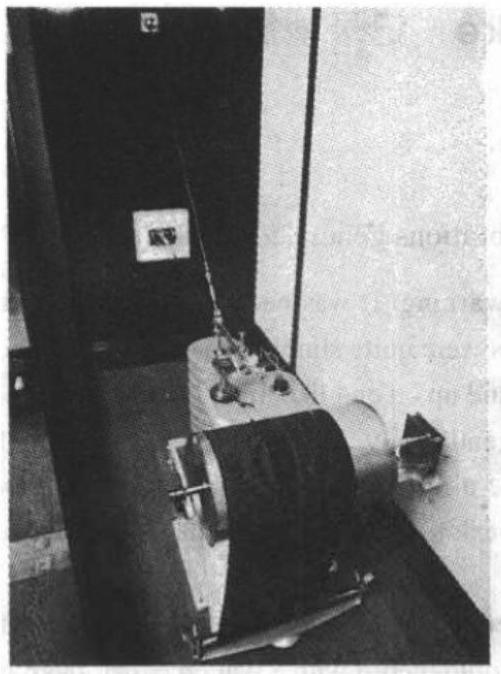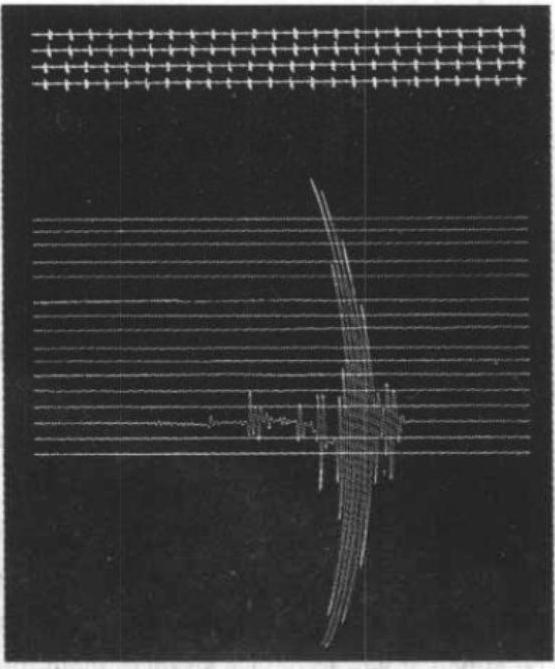Lesson 42 Recording an earthquake 记录地震
First listen and then answer the following question.
听录音,然后回答以下问题。
What does a pen have to do to record on paper the vibrations generated by an earthquake?
An earthquake comes like a thief in the night, without warning. It was necessary, therefore, to invent instruments that neither slumbered nor slept. Some devices were quite simple. One, for instance, consisted of rods of various lengths and thicknesses which would stand up on end like ninepins. When a shock came, it shook the rigid table upon which these stood. If it were gentle, only the more unstable rods fell. If it were
5 severe, they all fell. Thus the rods, by falling, and by the direction in which they fell, recorded for the slumbering scientist the strength of a shock that was too weak to waken him, and the direction from which it came.
But instruments far more delicate than that were needed if any really serious advance was to be made. The ideal to be aimed at was to devise an instrument that could record with a pen on paper, the movements 10 of the ground or of the table as the quake passed by. While I write my pen moves, but the paper keeps still. With practice, no doubt, I could in time learn to write by holding the pen still while the paper moved. That sounds a silly suggestion, but that was precisely the idea adopted in some of the early instruments (seismometers) for recording earthquake waves. But when table, penholder and paper are all moving, how is it possible to write legibly? The key to a solution of that problem lay in an everyday observation. Why does a
5 person standing in a bus or train tend to fall when a sudden start is made? It is because his feet move on, but his head stays still. A simple experiment will help us a little further. Tie a heavy weight at the end of a long piece of string. With the hand held high in the air, hold the string so that the weight nearly touches the ground. Now move the hand to and fro and around but not up and down. It will be found that the weight moves but slightly or not at all. Imagine a pen attached to the weight in such a way that its point rests upon
20 a piece of paper on the floor. Imagine an earthquake shock shaking the floor, the paper, you and your hand. In the midst of all this movement, the weight and the pen would be still. But as the paper moved from side to side under the pen point, its movement would be recorded in ink upon its surface. It was upon this principle that the first instruments were made, but the paper was wrapped round a drum which rotated slowly. As long as all was still, the pen drew a straight line, but while the drum was being shaken, the line that the pen was 5 drawing wriggled from side to side. The apparatus thus described, however, records only the horizontal component of the wave movement, which is, in fact, much more complicated. If we could actually see the path described by a particle, such as a sand grain in the rock, it would be more like that of a bluebottle buzzing round the room; it would be up and down, to and fro and from side to side. Instruments have been devised and can be so placed that all three elements can be recorded in different graphs.
When the instrument is situated at more than 700 miles from the earthquake centre, the graphic record shows three waves arriving one after the other at short intervals. The first records the arrival of longitudinal vibrations. The second marks the arrival of transverse vibrations which travel more slowly and arrive several minutes after the first. These two have travelled through the earth. It was from the study of these that so much was learnt about the interior of the earth. The third, or main wave, is the slowest and has travelled round the earth through the surface rocks.
H. H. Swinnerton The Earth beneath Us Unit 6 Lesson 42 An earthquake recorded on a seismograph

The Shaw seismograph at the Science Museum, London

New words and expressions 生词和短语
earthquake (title) $/3 : \theta$ kweık $/n$ . 地震 drum (1.23) $/\mathrm\lambda \mathrm{m}/n$ . 鼓状物
slumber (1.2) $/\prime \mathrm\Lambda \mathrm\partial /v$ . 睡眠 wriggle (1.25) / rɪɡəl/v. 扭动
ninepin (1.3) /'naɪnpɪn/ n. 九柱戏中的木柱 bluebottle (1.27) / bluːbɒtl/n. 绿头苍蝇
rigid (1.4) /'rɪdʒɪd/ adj. 坚硬的 graph (1.29) $/\mathrm$ æf/ $n$ . 图表
delicate (1.8) /'delɪkɪt/ adj. 灵敏的 graphic (1.30) /'græfik/adj. 图示的 seismometer (ll.12-13)/satz’mɒmɪtə/ $n$ . 地震仪 longitudinal (1.31) / , londʒi'tjuːdməl/ adj. 纵向的
penholder (1.13)/pen’həʊldə/ n. 笔杆 transverse (1.32) /'trænzvɜːs/ adj. 横向的
legibly (1.14) /'ledʒәbli/adv. 字迹清楚地
Notes on the text 课文注释
1 stand up on end, 竖立着。
2 the ideal to be aimed at, 理想的目标。
3 I could in time ..., 我最终能够 ……。
4 help us a little further, 帮助我们进一步搞清这个问题。
5 with the hand ... hold the string ..., 这是一个祈使句, 谓语动词是 hold, with the hand held high in the air 是介词短语作方式状语。
6 to and fro, 来回地。
Unit 6 Lesson 42
参考译文
地震就像夜间的小偷,不打招呼就来了。因此,有必要发明一种仪器,既不打盹儿,也不睡觉。有些装置非常简单。例如, 有一种装置是由一些长短、粗细不同的木棒组成, 就像九柱戏的木棒一样竖立着, 一旦有地震, 就会震动竖立在坚硬的桌子上的木棒。如果地震轻微,只有不稳定的木棒倒下;如果地震剧烈,所有的木棒都会倒下。由于地震太弱而未惊醒科学家时, 木棒倒下的多少和倒下的方向就为科学家记录下了地震的强度和地震方向。
但是, 如果要取得真正重大的进展, 需要有比这种装置精细得多的仪器。理想的目标是设计出这样一种仪器: 当地震发生时,它能用笔在纸上记录下大地和桌子的运动情况。我写字时,笔是移动的,纸是静止的。毫无疑问, 经过练习, 我最终能够学会笔不动而纸动来写字。这听起来似乎是一种愚蠢的想法, 但是早期记录地震波的仪器 (测震仪) 正是采用了这种思路。可是, 当桌子、夹笔装置、纸都在移动时, 怎么能书写得清楚呢? 可以从我们的日常生活观察中找到这个问题的答案。一个人站在公共汽车或火车上,当车突然开动时,他为什么会倾倒呢?这是因为他的脚动了,而他的头保持着静止。再做一个简单的实验可以帮助我们进一步理解这个问题。 把一个重物拴在一根长绳子的一端,把手高高举在空中握住绳子,让重物几乎接触地面。然后把手前后左右以及旋转摆动,但不要上下摆动。结果会发现,重物是动了,但动得很小,甚至没动。假定把一支笔拴在重物上,笔尖落在地板上的一张纸上,假定地震发生了,地板、纸、你和你的手都会动,重物和笔都却不运动。由于纸在笔尖下来回运动,纸的表面就会用墨水记录下地板运动的情况。根据这一原理,制造出了最初的地震仪器,但是纸是卷在慢慢旋转的圆筒上的。只要一切都是静止的, 笔就会划出一条直线; 但是, 圆筒受到震动, 笔所画出的线就会左右摆动。然而, 这里所说的仪器记录下来的只是地震波运动中的水平部分, 地震波的运动实际比这要复杂得多。假如我们真能看到诸如岩石中一个沙粒分子的运动轨迹, 那就像一只嗡嗡叫的绿头苍蝇在屋内飞行的轨迹, 呈现出上上下下、来来回回、左左右右 3 种性质的运动。已经设计出了一些仪器, 它按照一定的安放方式就可测绘出这三种运动的曲线图。
如果把这种仪器安装在距震源 700 多英里远的地方, 曲线纪录就能显示出前后相间的这 3 种地震波。首先记录下的是纵向波的到达; 然后记录下的是横向波的到达, 横向波比纵向波传播得慢, 在纵向波到达几分钟后才能到达。这两种波都是穿过地球而来的。正是从这两种波的研究中, 我们可以了解到地球内部的许多情况。 第三种波, 即主波, 是最慢的, 是围绕地球通过表面岩石传来的。
Comprehension 理解
Answer these questions:
1 Explain how the device consisting of rods of various lengths and thicknesses could be used to indicate the extent of an earthquake.
2 Why was this simple seismometer worked by rods unsatisfactory?
3 Which everyday observation enabled scientists to improve seismometers?
4 'Instruments have been devised and can be so placed that all three elements can be recorded in different graphs.' (ll.28-29) What are these 'elements'?
5 Why, during an earthquake, is the third wave the last to be recorded?
Vocabulary 词汇
Refer to the text to see how the following words have been used, then write sentences of your own using these words: rigid (1.4); slumbering (1.6); delicate (1.8); silly suggestion (1.12); legibly (1.14); everyday (1.14); tend (1.15); to and fro (1.18); slightly (1.19); rotated (1.23); wriggled (1.25); the path described by a particle (II.26-27); bluebottle (1.27).
Unit 6 Lesson 42
Summary 摘要
Drawing your information from lines 9-28 ('The ideal ... side to side.'), describe how the seismometer used for recording the horizontal component of wave movements works. Do not write more than 120 words. Use your own words as far as possible. Your answer should be in one paragraph.
Composition 作文
Write a composition of about 600 words on one of the following subjects:
1 A description, real or imaginary, of an earthquake.
2 The hidden forces of nature.
3 Man's efforts to understand and control natural calamities. (E.g. earthquakes, floods, hurricanes, tornadoes, tidal waves, volcanic eruptions, avalanches, forest fires.)
Key structures 关键句型
A Complete the following sentences in any way you wish. Then compare what you have written with the sentences in the passage:
1 When a shock came, it shook the rigid table upon which these stood. If it were gentle, (11.3-4)
2 _____ if any really serious advance was to be made. (1.8)
3 If we could actually see the path described by a particle, _____(II.26-28)
B Rewrite the sentences given below using the opening phrases provided. Do not refer to the passage until you have finished the exercise:
1 Though that sounds a silly suggestion, that was precisely the idea adopted in some of the early instruments.
That sounds _____ (ll.11-13)
2 The reason for this is that his feet move on, but his head stays still.
It is because _____ (ll.15-16)
3 Imagine that an earthquake shock shook the floor.
Imagine an _____ (1.20)
4 However, only the horizontal component of the wave movement, which is, in fact, far more complicated, is recorded by the apparatus thus described.
The apparatus thus described, however, _____ (11.25-26)
Special difficulties 难点
A Study the following pairs of words and then write sentences of your own to bring out the difference.
1 device (1.2) - devise (1.9)
The juice extractor is a practical household device.
He has devised a scheme for earning more money.
2 travel (1.32) - trip
She travels to London at least three times a month.
I'm just back from a business trip.
3 adopted (1.12) - adopted
The company has persuaded the workers to adopt more flexible working practices so as to increase efficiency.
Our Geology teacher has adapted an old washing-machine so he can use it to polish gem-stones. Unit 6 Lesson 42
B Note that the word record is differently pronounced in each of these sentences:
1 ... the graphic record shows three waves ... (ll.30-31)
2 The first records the arrival of longitudinal vibrations. (II.31-32)
Write pairs of sentences using the following words as nouns and as verbs: export; import; produce; conduct.
In each sentence indicate the syllable which should be stressed.
Multiple choice questions 多项选择题
Choose the correct answers to the following questions.
Comprehension 理解
1 Even a primitive instrument with rods can _____ .
(a) record the movement of an earthquake
(b) indicate roughly how strong an earthquake is and its direction
(c) wake up a sleeping scientist when an earthquake is in progress
(d) rise and fall in line with the movement of an earthquake
2 In a more sophisticated instrument to measure an earthquake _____
(a) the pen moves up and down as paper moves steadily beneath it
(b) the pen and the paper beneath it move together in response to the earthquake
(c) the pen remains still while recording the irregular movement of the paper beneath it
(d) the pen rotates with the moving drum beneath it
3 The instrument, consisting of a pen and paper moving round a rotating drum, _____
(a) gives a full picture of an earthquake
(b) records deep wave movements only
(c) does not provide a comprehensive record of an earthquake
(d) only reflects vertical movement
4 Instruments have been devised which will _____
(a) record all three movements of a nearby earthquake
(b) give a comprehensive record of an earthquake more than 700 miles away
(c) send information about the interior of the earth
(d) reflect the effect of an earthquake on surface rocks
Structure 句型
5 Falling rods recorded a shock that _____ to wake up the scientist. (II.5-6)
(a) was not enough strong (b) was strong enough
(c) was too strong (d) was not strong enough
6 Instruments of far _____ delicacy were needed. (1.8)
(a) improved (b) greater (c) better (d) finer
7 Where did the key to that problem _____ ? (1.14)
(a) laid (b) lied (c) lay (d) lie
8 _____ all was still, the pen drew a straight line. (ll.23-4)
(a) Provided (b) Suppose (c) Imagine (d) Supposed
Unit 6 Lesson 42
Vocabulary 词汇
9 While I write my pen moves, but the paper _____ . (1.10)
(b) changes direction
10 It will be found that the weight moves _____ slightly. (ll.18-19)
(b) unless (c) only
11 Instruments have been _____ and can be so placed ... (ll.28-29)
(c) sold (d) discovered
12 The graphic record shows three waves arriving _____ . (11.30-31)
(a) in a synchronised fashion (b) almost together
(c) irregularly (d) with brief breaks in between